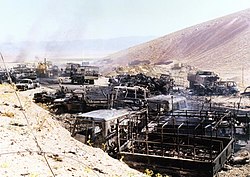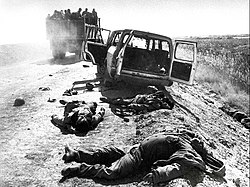Operation Mersad
 From Wikipedia - Reading time: 11 min
From Wikipedia - Reading time: 11 min
This article has multiple issues. Please help improve it or discuss these issues on the talk page. (Learn how and when to remove these messages)
|
| Operation Forough Javidan/Mersad | |||||||||
|---|---|---|---|---|---|---|---|---|---|
| Part of the Iran–Iraq War | |||||||||
 Burned-out vehicles in the aftermath of Operation Mersad | |||||||||
| |||||||||
| Belligerents | |||||||||
|
| |||||||||
| Commanders and leaders | |||||||||
|
| |||||||||
| Units involved | |||||||||
| |||||||||
| Strength | |||||||||
|
7,000 MEK troops[1] 300 tanks unknown number of artillery pieces and aircraft |
210,000 Iranians engaged 1,200,000 total 365 tanks unknown number of artillery pieces and aircraft | ||||||||
| Casualties and losses | |||||||||
|
1,500 to 2,506 KIA (Iranian claim)[2] 400 APCs 90 pieces of 80mm mortar 150 pieces of 60mm mortar 30 pieces of 106mm recoilless rifles[citation needed] | 480 KIA (Iranian claim)[7] | ||||||||
Operation Mersad (Persian: عملیات مرصاد, Operation Ambush) also called Operation Foroughe Javidan (Persian: عملیات فروغ جاویدان, Operation Eternal Light, MeK's codename) were among the last major military operations of the Iran–Iraq War.
In July 1988, during Iran-Iraq War, 7,000 militants from the People's Mojahedin Organization of Iran (MEK), with support from Iraq, invaded Iran, aiming to capture Kermanshah. Led by General Ali Sayad Shirazi, Operation Mersad began on July 26, 1988, and within just a few days, the Iranian Armed Forces successfully defeated the MEK forces.
Prelude and objectives
[edit]On 20 July 1987 the Iran–Iraq War was coming to an end under the United Nations Security Council Resolution 598.[8][9] Iran had suffered major defeats in southern Iraq during the Second Battle of Al Faw and Operation Tawakalna ala Allah as well as along the central portion of the border within Iran, and was contemplating on accepting[8] the ceasefire. The MEK-Iraqi operation Eternal Light would occur on 26 July 1988, six days after Ayatollah Khomeini had officially announced his acceptance of the UN brokered ceasefire resolution.[1]
Both Iran and Iraq had accepted United Nations Security Council Resolution 598, which would end the war on 8 August 1988. However, the Iraqi-backed Mujahedin-e-Khalq militant group seized the opportunity to attack central part of the Iran-Iraq border before the ceasefire came into effect.[1]
The attack agreed upon by the Iraqi leadership would be a two pronged assault. One portion of the MEK force would attack Iranian forces in northern Iraq, an area that was still in Iranian and Peshmerga hands. When the Iranian troops moved to fight off the MEK attack in northern Iraq, the opposition Iranian militant group Mujahedeen-e Khalq (MEK), supported by Iraqi air power, would launch a large scale incursion into the central portion of Iran, aiming towards the heart of Iran. The MEK under their leader Massoud Rajavi harbored the hope that the attack would lead to a general uprising against the Islamic government of Ayatollah Khomeini. Rajavi would lead the Mujahedeen with Iraqi support in an attack on the western borders of Iran.[10]
Saddam's official explanation for launching Operation Eternal Light was that he wanted to capture more Iranian POWs so as to exchange Iraqi POWs in Iran.[10] However, Dilip Hiro finds this explanation unconvincing. Instead Hiro argues Saddam wanted to impress Iraq's military superiority and wanted to end the Iran-Iraq war not in a stalemate but instead an Iraqi victory.[10]
Operations Eternal Light and Mersad
[edit]On 26 July 1988, the MEK, with the support of the Iraqi military, started Operation Forough Javidan (Eternal Light) in central Iran. In the face of Iraqi chemical attacks, Iran had evacuated Qasr-e Shirin and Sarpol-e Zahab.[10][6] These two towns were to be used by the MEK to push further into Iran.[10] On 26 July, the MEK advanced further into Iran in coordination with the Iraqi Air Force and captured Kerend-e Gharb and Islamabad-e Gharb.[1][10] At the latter, a large number of wounded Iranian soldiers were dragged from the city hospital and shot in the courtyard by the NLA forces. The MEK and Iraqi forces razed to ground the city of Islamabad-e Gharb, which had a population of 15,000.[10] This act alienated the local Kurdish population.[1] They also captured key strongholds along the Baghdad-Tehran highway.[1]
The MEK met scant resistance from the limited numbers of Revolutionary Guards, which were promptly defeated, pushing 145 km (90 mi) deep into Iran towards the provincial capital city of Kermanshah.[citation needed] Iran's Kurdish fighters did slow the advance, allowing time for the Iranians to prepare their counteroffensive.[1]
The MEK's next target was the provincial capital city of Kermanshah, with a population of 500,000. Iran allowed the MEK to advance to the city but had prepared an ambush.[1] This counterattack, called Operation Mersad was led by Lieutenant General Ali Sayyad Shirazi.[citation needed] Iran cut off MEK's supply lines,[10] by landing paratroopers behind them.[citation needed]
As the Iraqi airforce did not venture beyond Islamabad-e Gharb,[10] Iranian airforce attacked the MEK forces. Iranian Air Force F-4 Phantoms[1] bombed Mujahedeen convoys on the Kermanshah highway, followed by Army Aviation helicopters using anti-tank missiles.[1] Most enemy armour was destroyed, in a miniature version of the Highway of Death during the Persian Gulf War.[1]
The MEK advance had been abruptly and completely halted. The Iranian army and Revolutionary Guard then moved north from Khuzestan, encircling and suppressing the remaining resistance in the city of Kerend-e Gharb on 29 July 1988.[citation needed]
On 31 July, Iran drove MEK forces out of Qasr-e-Shirin and Sarpol Zahab, though the MEK claimed to have "voluntarily withdrawn" from the towns. Iran estimated that 4,500 Mujahedeen soldiers were killed, while 400 Iranian soldiers died. Many senior MEK commanders were killed,[6] and many MEK militants were not given quarter.[6] Iran claimed it destroyed 200 tanks and 700 other vehicles.[6]
The Iranian successes during Operation Mersad were partially because of effective coordination between the Army and the Revolutionary Guard.[11]
Aftermath
[edit]This section includes a list of general references, but it lacks sufficient corresponding inline citations. (May 2019) |

The corpses of killed MEK members were not collected and were left on the battlefield.[12] Operation Mersad was the last land battle of the Iran–Iraq War.
The last notable combat actions of the war took place on 3 August 1988, in the Persian Gulf when the Iranian navy fired on a freighter and Iraq launched chemical attacks on Iranian civilians, killing an unknown number of them and wounding 2,300.
Resolution 598 came into effect on 8 August 1988, ending all combat operations between the two countries.[102] By 20 August 1988, peace with Iran was restored. UN peacekeepers belonging to the UNIIMOG mission took the field, remaining on the Iran–Iraq border until 1991. While the war was now over, Iraq spent the rest of August and early September clearing the Kurdish resistance. Using 60,000 troops along with helicopter gunships, chemical weapons (poison gas), and mass executions, Iraq hit 15 villages, killing rebels and civilians, and forced tens of thousands of Kurds to relocate to forced settlements.[99] Many Kurdish civilians immigrated to Iran. By 3 September 1988, the anti-Kurd campaign ended, and all resistance had been crushed.[99] 400 Iraqi soldiers and 50,000 Kurdish civilians and soldiers had been killed.
At least in part as a response to the invasion, Iran executed several thousand political prisoners across the country for treason, mainly members of the MEK, but also members of the Tudeh Party (Communist Party) and other opposition groups.[citation needed] The estimates for number of executions vary from as little as 1,400 to as high as 12,000.[citation needed] The most likely number was given by dissident Ayatollah Hussein-Ali Montazeri, as being between 3,800–4,500.[13] The death toll may have been higher for those MEK executed by frontline courts-martial or dying in prison.
Ali Sayad Shirazi was the Iranian commander responsible for the coordination between the Revolutionary Guard and the Iranian army, that was responsible for the success of Operation Mersad. In April 1999, an MEK operative posing as a roadsweeper killed Shirazi outside his home.[11]
Bibliography
[edit]- Farrokh, Kaveh (20 December 2011). Iran at War: 1500–1988. Osprey Publishing. p. 609. ISBN 978-1-78096-221-4.
- "The Lessons of Modern War - Volume II - The Iran–Iraq War (Chapter 10: The Combination Of Iraqi Offensives And Western Intervention Force Iran To Accept A Cease-Fire: September 1987 To March 1989) - May, 1990 - 9005lessonsiraniraqii-chap10.pdf" (PDF). Archived from the original (PDF) on 7 June 2013. Retrieved 10 October 2014.
See also
[edit]References
[edit]- ^ a b c d e f g h i j k l Farrokh, Kaveh (20 December 2011). Iran at War: 1500–1988. Oxford: Osprey Publishing. pp. 413–414. ISBN 978-1-78096-221-4.
- ^ a b c d Yaghoub Nemati Voroujeni (Summer 2012), "Mujahadeen-e-Khalq (MEK) Organization in the Imposed War", Negin-e-Iran (in Persian), 41 (11): 75–96, archived from the original on 18 November 2016, retrieved 2 December 2016
- ^ بخشهایی از گزارش نهایی ستاد فرماندهی ارتش آزادیبخش ملی ایران درباره عملیات بزرگ فروغ جاویدان ـ ۸ شهریور ۱۳۶۷
- ^ "The Cult of Rajavi" by Elizabeth Rubin. New York Times, 13 July 2003
- ^ Lamb, Christina (19 June 2001). "Khomeini fatwa 'led to killing of 30,000 in Iran'". The Daily Telegraph. Archived from the original on 29 March 2008. Retrieved 10 October 2014.
- ^ a b c d e Michael Axworthy. Revolutionary Iran: A History of the Islamic Republic. Oxford University Press. p. 283.
- ^ "روایت حاج سعید از عملیات مرصاد". YouTube.
- ^ a b "Basis for an End to Persian Gulf Fighting: Security Council Resolution 598". The New York Times. 19 July 1988.
- ^ "Iraq-Islamic Republic of Iran". unscr.
- ^ a b c d e f g h i Hiro, Dilip, The Longest War, (1999), pp. 246–47
- ^ a b Mahan Abedin. Iran Resurgent The Rise and Rise of the Shia State. Hurst. pp. 110–111.
- ^ "برخی فرزندان خود را به همسایه سپردند تا به "فروغ جاویدان" برسند/ بعد از ترور صیاد جشن گرفتند و شام دادند". Fars News (in Persian). 24 July 2016. Retrieved 31 March 2024.
- ^ "The Bloody Red Summer of 1988". FRONTLINE – Tehran Bureau. Retrieved 10 October 2014.
External links
[edit] Media related to Operation Mersad at Wikimedia Commons
Media related to Operation Mersad at Wikimedia Commons- sajed.ir in English – The Official site of Holy Defence – Iraq-Iran War 1980–88 Archived 7 July 2007 at the Wayback Machine
 KSF
KSF